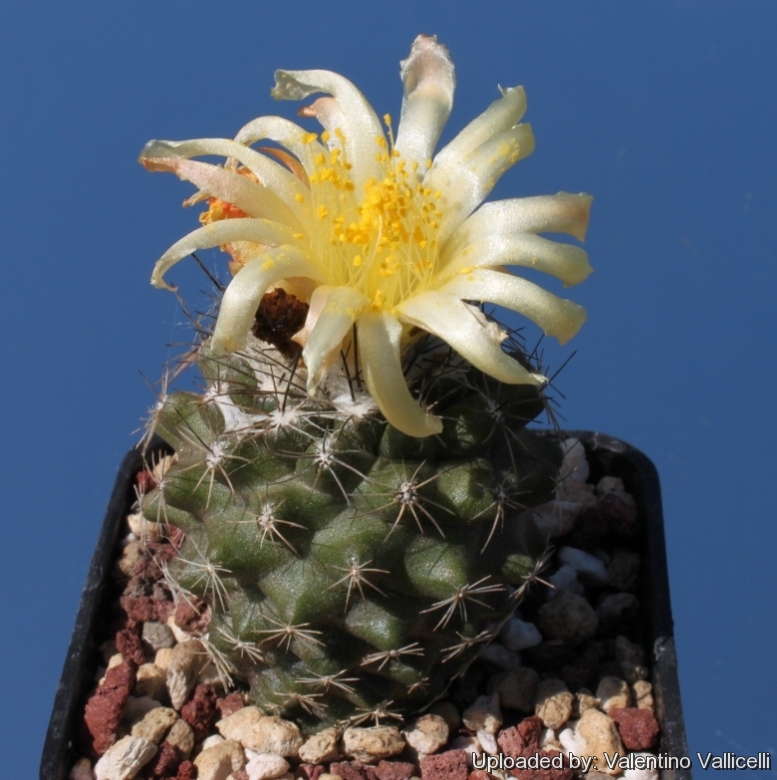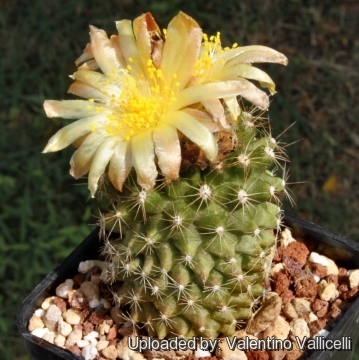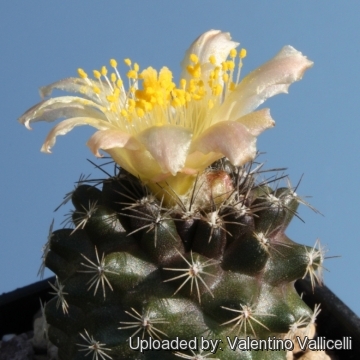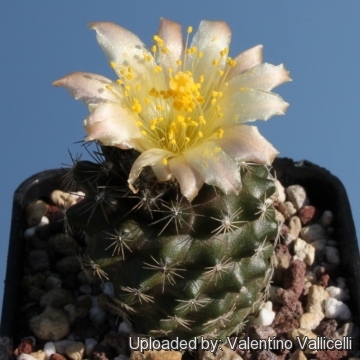
Copiapoa humilis var. tocopillana Photo by: Valentino Vallicelli
L806 (Collector: Alfred Bernhard Lau) Locality: Tocopilla, Antofagasta, Chile. Altitude: 350-600m. (Grows together with L807, Eriosyce laui)
Origin and Habitat: Chile ( Region II Antofagasta: Tocopilla)
Altitude: 300-1100 metres
Habitat: This is the most northerly Copiapoa known to exist today that inhabit the extremely dry hills near Tocopilla. It grows deep seated within rock crevices and is very difficult to find. Its survival is seriously threatened both to aridity and human activities (many small mines on the coastal hills, south of Tocopilla). Despite the lack of rain where it lives, the extreme aridity is attenuated by the frequent, often dense, coastal fogs. The fog tends to concentrate in the form of a cloud band at an estimated height of 500 to 850 m. It shows a recurrent pattern; usually it is overcast in the early mornings, the clouds dissipating during the late morning and returning during the late afternoons. It grows together with Neoporteria residuaSN|2888]]SN|2888]], Eulychnia aricensisSN|8188]]SN|7529]], Eulychnia iquiquensisSN|7529]]SN|8188]], Eriosyce lauiSN|2876]]SN|2743]], Neochilenia iquiquensis, Neochilenia saxifraga, Trichocereus deserticolusSN|7893]]SN|7893]], Cumulopuntia sphaericaSN|4198]]SN|4198]], and Eriosyce reconditaSN|2743]]SN|2876]].
Synonyms:
See all synonyms of Copiapoa humilis
Common Names include:
SPANISH (Español): Tocopillano
Description: Copiapoa tocopillanaSN|9790]]SN|1326]] (now considered a subspecies of Copiapoa humilisSN|1326]]SN|9790]]) is a tiny cactus with white, woolly heads. It is the most northern Copiapoa, as well as one of the least attractive, it is a very uncommon plant rarely seen in collections.
Habit: Usually solitary.
Stem: Glaucous-green to greyish green, globose to short cylindrical (approx.
three times longer than broad), densely covered by spines. Apex white-woolly only in adult plants.
Root: Napiform single or branched, firm, 10-30 cm long and 2-3 cm wide, with a narrow neck about 10 cm long.
Ribs:* (7-) 10-14, barely evident in young plants, forming distinct spiralling tubercles.
Tubercles: Rounded-obtuse 4-6 mm long and wide, sometimes with a keel under the areola.
Areoles: Round 3-5 mm in diameter, grey felted, 5-10 mm apart.
Spines:* 1-3 cm long, acicular, straight to slightly curved upward, maroon or blackish, with whitish bases.
Radial spines 10-12, all almost the same size 10-25 mm long.
Central spines: 1-4 only slightly stronger, 1-4 cm long.
Flowers: Diurnal closing at night, scentless, protracting the period of opening many days, lemon yellow, 2,3-2,5 cm long. Ovary almost spherical, 3,5-5 mm in diameter, pale, with 0-4 coffee-red scales evenly distributed, short and narrow 3-5 mm long and 0, 5-1 mm wide, hairless or with small tufts of woolliness. Tubular nectaries 1-1, 5 mm high, narrow at the base of the Stamens. Tube funnel-shaped 7-8 mm long, inside bright yellow outside, pale with few coffee-red narrow scales, 7-10 mm long, 2-3 mm wide, hairless. Filaments yellow 5-7 mm long, the of upper ones more short. Anthers and pollen golden yellow. Style bright yellow, 10-12 mm long with 6-7 yellow stigma lobes 2-3 mm long. Tepals lemon yellow, with a reddish-brown mid-line on the outside all 10-12 mm long, 2,5-4 mm wide, short to long somewhat lanceolate and narrow.
Fruits: brownish red.
Seeds: 1,4 mm long, 1 mm wide, 0,7 mm broad. Testa black, glossy, almost smooth or finely tuberculate; Hilum oval, whitish.
Remarks: Copiapoa tocopillanaSN|9790]]SN|1326]] is strictly related with Copiapoa humilisSN|1326]]SN|9790]] but the latter distinguishes for its softer darker coloured body, growth more flattened, ribs more high, flower larger with strong fragrance, ovary always glabrous, with smaller scales inserted only above the peripheral ring, nectaries more large, wider and more open, stamens more long, lobes of the stigma more numerous and seeds more wide.
Subspecies, varieties, forms and cultivars of plants belonging to the Copiapoa humilis group
 Copiapoa humilis var. tocopillana Photo by: Valentino Vallicelli
Copiapoa humilis var. tocopillana Photo by: Valentino Vallicelli Copiapoa humilis var. tocopillana Photo by: Valentino Vallicelli
Copiapoa humilis var. tocopillana Photo by: Valentino Vallicelli Copiapoa humilis var. tocopillana Photo by: Valentino Vallicelli
Copiapoa humilis var. tocopillana Photo by: Valentino VallicelliSend a photo of this plant.The gallery now contains thousands of pictures, however it is possible to do even more. We are, of course, seeking photos of species not yet shown in the gallery but not only that, we are also looking for better pictures than those already present.
Read More... Cultivation and Propagation: Considering that Copiapoa tocopillanaSN|1326]]SN|1326]] comes from a habitat with an extremely arid climate, they are remarkably tolerant of pot culture. These plants have thick taproots and are susceptible to overwatering. They requires also an appropriate air circulation. Copiapoas are summer grower species easy to cultivate
Growth rate: It is a relatively rapidly growing and easily flowering species that will make clumps given the best conditions.
Soils: It likes very coarse mineral cactus mix soil, but can become too elongated if compost is too rich.
Repotting: Use pot with good drainage.
Watering: Water moderately from Spring to Autumn, but do not overwater (Rot prone), it must be strictly kept dry throughout the winter quiescent period since it is very sensitive to any moisture excesses keep dry in winter.
Fertilization: Feed with a high potassium fertilizer in summer.
Hardiness: They need to be kept in a cool place during winter rest and are resistant to light frost if kept on the dry side prior to, and during, cold weather ( they are hardy to -4 C ° C short periods). However some warmth throughout the year will increase the grower's success (minimum 5° to 8°C during rest season).
Exposition: Requires full sun or light shade and careful watering to keep plant compact with strong coloured spines. Tends to bronze in strong light, which encourages flowering and heavy spine production. Light shadow my be useful in the hottest summer days.
Uses: It is an excellent plant for container growing. It always looks good and stays small. It look fine in a cold greenhouse and frame or outdoor in a rockery.
Pests & diseases: It may be attractive to a variety of insects, but plants in good condition should be nearly pest-free, particularly if they are grown in a mineral potting-mix, with good exposure and ventilation. Nonetheless, there are several pests to watch for:
- Red spiders: Red spiders may be effectively rubbed up by watering the infested plants from above.
- Mealy bugs: Mealy bugs occasionally develop aerial into the new growth among the wool with disfiguring results, but the worst types develop underground on the roots and are invisible except by their effects.
- Sciara Flies: Sciara flies are one of the major problems for seedlings. It is a good practice to mulch your seedlings with a layer of grit, which will strongly discourage the flies.
- Scales: Scales are rarely a problem. It is wise to treat your whole collection with a systemic insecticide twice a year in spring and autumn.
- Rot: Rot is only a minor problem with cacti if the plants are watered and “aired” correctly. If they are not, fungicides won't help all that much. To prevent rottenness it is also advisable to surround its root neck by very rough sand or grit, this help a fast water drainage.
Propagation: Seed, cutting, grafting. Seeds germinate in 7-14 days at 21-27° C in spring, remove gradually the glass cover as soon the plants will be well rooted (ca 1-2 weeks) and keep ventilated, no full sun for young plants!














